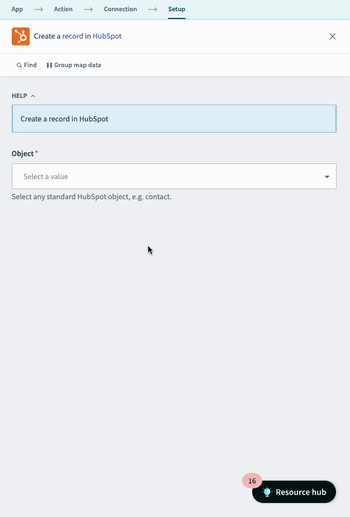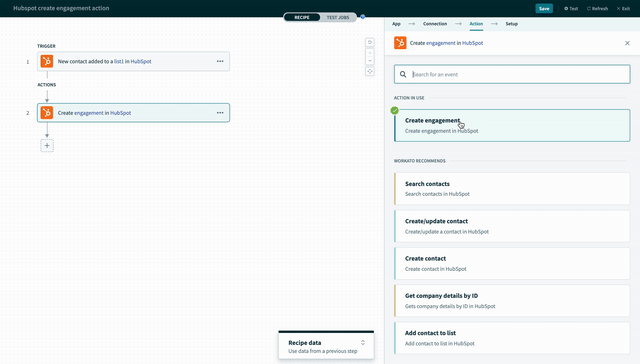# HubSpot - Create Records Actions
These actions will allow you to create records in your HubSpot instance with the given properties and receives the details of the created record, including the ID.
Workato currently supports the following create actions:
- Create Record Action
- Create Batch Records Action
- Create an Engagement Action
Deprecation Notice
The actions below have been deprecated. Please use the newly released Create Records or Create Records Batch actions instead.
- Create Company action
- Create Contact action
- Create Deal action
# Create record / Create record batch action
This action allows you to create any record (or batch of records) in HubSpot. Furthermore, you can specify the values of relevant properties during creation. We currently support the following objects:
- Contact
- Company
- Deal
- Product
- Ticket
- Line Item
- Quote
- Custom Objects

If you provide a company's website domain name, HubSpot will attempt to automatically populate some properties with HubSpot Insights. Learn how to disable this feature.
# Input Fields
To configure these actions, you will need to first select the object you want to update records of. Once the relevant object has been selected it's associated properties will be populated. Please ensure that required fields are populated to prevent an error when attempting to create the record.
# Output Fields
Workato will return an object representing each created record so you can use its datapills in the subsequent steps. The datapills pertaining to ID, Created At, Updated At and Archived will always contain a value. The remaining datapills will contain information if the corresponding field had information when created. Take note that some fields may pass in default values and these will be returned as well.
# Create an engagement
This action creates an engagement(an email, call, meeting, task, or note) on an object in HubSpot. An engagement is useful for keeping your CRM records up-to-date on any interactions that take place outside of HubSpot. Activity reporting in the CRM also feeds off of this data.

# Input fields
| Input field | Description | |
|---|---|---|
| Engagement | Active | Whether the engagement is active. |
| Type | The type of engagement. The available values are: Email, Call, Meeting,Task, Note | |
| Timestamp | This timestamp will be treated as the time that the engagement happened, and will determine where the engagement appears in the timeline for any associated records. | |
| Owner ID | Owner ID of the engagement. Task engagements use the ownerId to populate the Assigned to field. | |
| Associations | Contact | Contact IDs to be associated with the engagement. You can associate engagements with objects to ensure they're displayed correctly in the UI. |
| Company | Company IDs to be associated with the engagement. You can associate engagements with objects to ensure they're displayed correctly in the UI. | |
| Deal | Deal IDs to be associated with the engagement. You can associate engagements with objects to ensure they're displayed correctly in the UI. | |
| Owner | Owner IDs to be associated with the engagement. You can associate engagements with objects to ensure they're displayed correctly in the UI. | |
| Attachments | ID of items to be attached to the engagement. | |
# Output fields
If the request is successful, Workato will return a record representing the newly created engagement so you can use its datapills in the subsequent steps. Click here to view the fields available.
Last updated: 2/20/2023, 2:19:20 PM